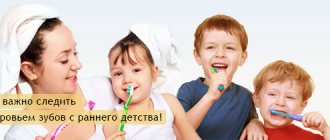Temporary teeth
Timing of teething
Dental buds are formed during the period of intrauterine development. The eruption of the first teeth begins at the twenty-fifth week of the baby’s life. The lower incisors appear first, followed by the upper ones by eight months. The age at which baby teeth, called premolars, erupt varies from one to two years. The last to appear are the canines and second premolars, which occurs from sixteen to thirty months.
This teething schedule is optimal, but it is impossible to determine the exact timing. The process depends on the characteristics of the child’s body, the health of the mother during pregnancy and genetic factors.
Timing of teething in children in the table
| Type of tooth | Lower jaw | Upper jaw |
| Medial incisor | 6 – 10 months | 7 – 12 months |
| Lateral incisor | 7 – 16 months | 9 – 13 months |
| Fang | 16 – 23 months | 16 – 22 months |
| First premolar (baby molar) | 12 – 18 months | 13 – 19 months |
| Second premolar (baby molar) | 20 – 31 months | 25 – 33 months |
The order of teething in children
The teeth follow the principle of pairing, for example, if one fang appears, a second one should be expected soon. The sequence of teething is determined by nature based on the practical significance of dental units for survival.
The front teeth of the lower row grow first, then the upper ones come. The lateral incisors disrupt the order of teeth eruption; their appearance begins with the upper jaw. Then comes the eruption of chewing teeth - the first premolars. The last to emerge are the canines and molars. The process of teething in children is completed by the age of 2-3 years.
Diagram of baby teeth eruption in children
Permanent teeth
Timing of teething in children
The first permanent teeth appear several months before the baby teeth fall out—the molars, or “sixes,” erupt. This occurs at the age of six. By the age of eight or nine years, it is the turn of the incisors. When a child is ten to twelve years old, premolars and canines erupt. Next come the second molars, the eruption of molars is completed by adulthood.
Important!
Wisdom teeth appear much later, after twenty years. However, their complete absence is also the norm.
Timing of teething in the table
| Name | Lower jaw - time of eruption | Upper jaw - eruption time |
| Medial incisor | 6 - 7 years | 7 - 8 years |
| Lateral incisor | 7 - 8 years | 8 - 9 years |
| Fang | 9 - 10 years | 11 - 12 years |
| First premolar | 10 - 12 years | 10 - 11 years |
| Second premolar | 11 - 12 years | 11 - 12 years |
| First molar | 6 - 7 years | 6 - 7 years |
| Second molar | 11 – 13 years | 12 - 13 years old |
| Third molar | 17 – 21 years old | 17 – 21 years old |
Teething order
The pairing principle also applies to permanent dental units. The correct sequence of teething is important for the formation of the bite; it is necessary to carefully monitor the time of loss of baby teeth and the order of growth of molars.
The lower molars appear first, then the upper ones. Next, the temporary teeth of the lower jaw fall out, the permanent teeth erupt, and only then the upper dental units are replaced.
This schedule for teething in children is not universal, but if there are significant deviations, you should consult a specialist.
Signs of teething
Symptoms of teething in infants
The appearance of baby teeth is a little more difficult than that of permanent teeth, since the baby has not yet encountered pain and cannot understand what is happening to him. Teething in children under one year of age is accompanied by the following signs.
- The most common symptom of teething is fever. An increase to 38 degrees within three days is normal.
- Swelling of the gums. Often, when children are teething, their gums swell, their sockets itch, and they have a desire to chew hard objects. It is important to prevent the child from damaging the mucous membrane; it is better to buy a special teether to relieve discomfort.
- Decreased appetite. Children refuse to eat due to stress or itchy gums.
- Teething syndrome. Neurosis, tearfulness, anxiety, poor sleep and whims may indicate the imminent appearance of the first tooth, even if the child does not experience pain, fever or swelling of the gums.
Important!
An increase in white blood cell levels during teething should not be a cause for alarm. This is a common occurrence associated with a weakened immune system.
Symptoms of eruption of permanent teeth
A change in temporary bite is accompanied by other unpleasant sensations. The process has the following characteristics.
- Root resorption and loss of baby teeth. A sure signal of the appearance of a new tooth in the coming months.
- Increase in jaw bone size. Permanent teeth are larger than baby teeth, the jaw grows, creating conditions for a change in bite.
- Pain in the gums. Redness and swelling of the mucous membrane are a reaction to teething.
Important!
Body temperature above 38 degrees, cramps, refusal to eat and difficulty breathing are not symptoms of the appearance of milk and permanent teeth. These are signs of an infectious disease. It is necessary to urgently consult a doctor.
The child is teething... How to help?
There is a popular saying: if a child is actively drooling, it means that his first teeth will soon appear. My personal experience does not confirm this wisdom. From two to three months everyone starts drooling, and teeth appear, as a rule, after six months.
The time for teeth to appear (with normal nutrition and care) depends mainly on heredity - of course, within certain limits. There is no reason to worry if everything is absolutely normal, the child is nine months old and has no teeth.
It simply doesn’t happen that teeth don’t grow at all. But no way to influence the timing of teething.
And there is no relationship between the state of the child’s health and the timing of teething. So there is no need to be nervous and worry in vain!
A deviation from the average teething norms of 6 months in one direction or another is considered normal!
Teeth cutting in the “wrong” sequence is not a sign of illness!
There are no medications that can affect the timing and sequence of teething!
However, there are a huge number of medications in the form of pleasant-tasting gels that are rubbed on a child’s gums, thus facilitating teething.
Such gels are divided into two groups - those containing a local anesthetic (usually benzocaine or lidocaine) and those not containing it.
Medical science strongly does not recommend the use of gels with benzocaine or lidocaine, as they provoke deadly complications, especially seizures and heart rhythm disturbances.
Carefully study the instructions for dental gels! If you find the word “benzocaine” or “lidocaine” in the product, do not buy it!
***
And now just some useful information.
The order of the teeth is recorded in the form of a dental formula. Individual teeth are designated by numbers. Each tooth has its own serial number, and the countdown starts from the center. The two rows of numbers in the dental formula correspond to the teeth on the upper and lower jaw.
| Age | Dental formula |
| 6–7 months | |
| 1 1 | |
| 8–9 months | 1 1 |
| 1 1 | |
| 10 months | 2 1 1 2 |
| 1 1 | |
| 12 months | 2 1 1 2 |
| 2 1 1 2 | |
| 12–15 months | 3 2 1 1 2 3 |
| 3 2 1 1 2 3 | |
| 18–20 months | 4 3 2 1 1 2 3 4 |
| 4 3 2 1 1 2 3 4 | |
| 20–30 months | 5 4 3 2 1 1 2 3 4 5 |
| 5 4 3 2 1 1 2 3 4 5 |
And one moment. Medical science believes that teething is very rarely accompanied by the development of a painful condition. But both practicing doctors (including the author) and the overwhelming majority of parents often observe how a seemingly healthy child suddenly, for no reason at all, deteriorates in mood, the temperature rises, and sometimes diarrhea begins. And after two or three days the tooth erupts, and everything goes away.
Symptoms of teething often include very severe itching of the gums, to satisfy which the baby pulls into the mouth everything that can be stuffed there.
It is not surprising that when a child is teething, the likelihood of swallowing a foreign body, getting a foreign body into the respiratory tract, and even the risk of intestinal infections increases significantly.
A safe, inexpensive, pleasant and effective method of assistance, highly recommended in the described situation, is the use of special teethers.
A teether is a wonderful device used, as the name suggests, during the teething stage. The teether safely relieves pain and itching of the gums, because you can gnaw and bite without any restrictions. The analgesic effect can be enhanced by pre-cooling the teether in the refrigerator or cold water.
You should know that teethers:
- made of rubber, silicone, latex, plastic, even wood;
- They often have a special shape designed to help with the eruption of certain teeth - lower anterior, upper anterior, lateral. But most often, teethers are universal, and this is written on the packaging;
- they often have bumps on the part that enters the mouth, allowing them to effectively massage the gums;
- As a rule, they are produced in a form resembling a ring, and this ring is convenient for a child to hold, chew, and examine.
Continuing the conversation about teeth, we note that there is no need to put off teaching your child to brush them until later. The first teeth have appeared - let's start brushing them! Moreover, the main attention should be paid not to care products (toothpastes, powders), but to the process itself, the need to brush your teeth with brushes. It is most convenient to begin this training in the bathroom - as a rule, the time when the child begins to sit in a large bathtub and the time when his first tooth appears coincides.
A special finger brush, as the name suggests, is placed on mom or dad’s finger and the exciting game of brushing your teeth begins. Your child will understand the rules of the game much faster if he sees you brushing your teeth.
The process of brushing teeth with a brush placed on the parents’ finger, as a rule, does not last long, since the child quickly develops a desire (reinforced by the opportunity) to do it on his own, especially if he constantly sees mom and dad doing this activity. This is where it comes time for your first personal brush. The first toothbrush should look something like the picture below. Its fundamental feature is a special limiter that regulates the depth of immersion in the mouth.
The first tooth, which most often appears around 6 months, also signals the baby’s readiness for complementary feeding. And during this fascinating process, you will definitely need a wonderful device with a name that is still unusual for our ears - a nibbler. Using a nibbler is very convenient to introduce your child to various vegetables and fruits. Moreover, the use of fruit juices, especially ready-made ones produced industrially, is not actively recommended by modern medical science.
Giving fruit juices to children is a tradition favored by the majority of the population, but needs to be re-evaluated because fruit juices contain excess calories and sugar and are low in nutritional value. As a result: the child willingly drinks sweet juice, instead of receiving truly healthy natural fruits and other foods containing carbohydrates, proteins, fats, fiber, calcium and other macro- and microelements.
So, the nibbler is a wonderful device for feeding a baby. It is a nylon mesh or silicone nozzle with numerous holes, attached to a base with a handle. Products used for complementary feeding are placed in the nibbler - usually vegetables, fruits, berries, and somewhat less often - bread, cookies, crackers, hard cheeses, etc. The child absorbs (softens) the contents of the nibbler and gets acquainted with new tastes without risk choke.
And a nibbler with chilled contents (for example, an apple straight from the refrigerator) is a wonderful way to relieve itchy gums during teething.
Also, with the help of a nibbler, you can introduce your child to a variety of tastes and foods early enough, and this, according to modern scientists, greatly reduces the risk of developing food allergies.
Just remember the main rule: thoroughly washing out food debris from the mesh and holes is the most important condition for the safe use of the nibbler.
All these very necessary items are included in the Tiny “First Tooth” set. But this is not just a set of individual products - it is a continuation of Dr. Komarovsky’s ideology to preserve the health of your child.
Each of the items is the result of careful selection, testing and scrupulous analysis of what the baby and his parents really need.
The contents of the set clearly correspond to the name - two teethers, finger toothbrushes (two sizes), the first individual toothbrush and a nibbler.
I think that once you start using all the items, you will appreciate this gift for mothers from Dr. Komarovsky.
author Komarovsky E.O. published 29/03/2018 17:57 updated 25/10/2020 — Lifestyle, Family
Painful teething: advice for parents
When faced with teething in children, many parents are at a loss. First of all, you need to call an ambulance and determine the reason for the baby’s poor health. If symptoms are confirmed, the specialist will prescribe medications for teething - antipyretics and painkillers.
You can treat your gums yourself with an anesthetic gel with a cooling effect to reduce itching and swelling of the mucous membrane. Ice will also help. To reduce gum irritation, there are special silicone fingertips made of hypoallergenic material.
Folk remedies for teething will effectively relieve painful sensations - a decoction of chamomile, sage, tincture of valerian and honey will soothe inflamed tissues.
Painkillers for teething are contraindicated in children; this can worsen their health.
Important!
Without a doctor's recommendation, antibiotics and other strong teething medications can cause an allergic reaction.
Folk remedies
Medicines are effective for teething, but what should you give a child when teeth are cutting and you don’t want to use synthetic drugs? Home methods are auxiliary because they cannot always completely eliminate pain. However, for some children, these options are the most preferable and really help cope with pain. Doctors sometimes advise using:
- Compresses with chamomile. It is necessary to moisten a bandage or cotton pad in chamomile infusion and then apply it to the painful cheek. To relieve inflammation and swelling, dentists recommend giving several teaspoons of herbal tea.
- Honey. If the baby is not prone to allergic reactions, you can lubricate the inflamed mucous membranes with a honey substance. You should rub the substance in carefully, otherwise the baby will simply swallow it, and all manipulations will be useless.
- Soda solution. It is recommended to dissolve 1 tsp. soda in a glass of clean warm boiled water, dip a gauze cloth and wipe the gums. This product helps not only relieve pain, but also disinfect the surface.
Before using traditional methods, you must always consult a doctor, even if the herbal substances used are considered completely safe. Sign up for a consultation at the dental office, our specialists will recommend effective formulations that will not harm the little patient.
Deviations in teething
Minor changes in the timing and sequence of dental growth should not cause alarm. However, significant deviations from the norm in teething are a cause for concern.
- The tooth does not appear for a long time. Reason: genetic predisposition to long eruption or lack of rudiments.
- Too early appearance of teeth. Caused by disruption of the endocrine system.
- Black or brown enamel surface color. Indicates high iron levels, poor salivation, or chronic inflammatory processes in the child’s body.
- Incorrect row position. Bite pathologies indicate a hereditary factor or deformation of the maxillofacial bone.
Will calcium supplements help strengthen teeth?
When it comes to adults, dentists answer this question in the negative. After all, calcium accumulates in the tooth tissue during its formation. And that’s when it is needed to strengthen teeth. When this process is over and the tooth has erupted, neither calcium nor other minerals enter the dental tissue from the blood.
In other words, you can take calcium supplements or eat cottage cheese and cheese every day, but you won’t be able to strengthen your teeth this way - they were fully formed in your childhood.
Nevertheless, dentists recommend eating a little cheese after a “sweet” meal. And although calcium from it will not get into the tooth enamel, cheese promotes the appearance of saliva, which cleanses the oral cavity. In addition, the calcium contained in cheese neutralizes the acidity of saliva, which prevents the destruction of enamel.
As for calcium supplements, they should be taken after consultation with a doctor, who can determine the lack of this element in the body.










